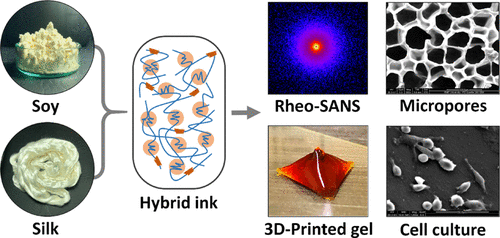当前位置:
X-MOL 学术
›
Biomacromolecules
›
论文详情
Our official English website, www.x-mol.net, welcomes your feedback! (Note: you will need to create a separate account there.)
3D Printable Soy/Silk Hybrid Hydrogels for Tissue Engineering Applications
Biomacromolecules ( IF 6.2 ) Pub Date : 2021-08-30 , DOI: 10.1021/acs.biomac.1c00250 Pramod Dorishetty 1 , Rajkamal Balu 1 , Amy Gelmi 2 , Jitendra P Mata 3 , Naba K Dutta 1 , Namita Roy Choudhury 1
Biomacromolecules ( IF 6.2 ) Pub Date : 2021-08-30 , DOI: 10.1021/acs.biomac.1c00250 Pramod Dorishetty 1 , Rajkamal Balu 1 , Amy Gelmi 2 , Jitendra P Mata 3 , Naba K Dutta 1 , Namita Roy Choudhury 1
Affiliation

|
The development of protein-based 3D printable hydrogel systems with tunable structure and properties is a critical challenge in contemporary biomedicine. Particularly, 3D printing of modular hydrogels comprising different types of protein tertiary structure, such as globular and fibrous, has not yet been achieved. Here we report the extrusion-based 3D printing of hybrid hydrogels photochemically co-cross-linked between globular soy protein isolate (SPI) and fibrous silk fibroin (SF) for the first time. The hierarchical structure and organization of pristine SPI and SF, and 1:3 (SPI/SF) hybrid inks under various shear stress were investigated using in situ rheology combined with small-/ultra-small-angle neutron scattering (Rheo-SANS/USANS). The hybrid ink exhibited an isotropic mass fractal structure that was stable between tested shear rates of 0.1 and 100 s–1 (near printing shear). The kinetics of sol–gel transition during the photo-cross-linking reaction and the micromechanical properties of fabricated hydrogels were investigated using photorheology and atomic force microscopy, where the hybrid hydrogels exhibited tunable storage and Young’s moduli in the range of 13–29 and 214–811 kPa, respectively. The cross-link density and printing accuracy of hybrid hydrogels and inks were observed to increase with the increase in SF content. The 3D printed hybrid hydrogels exhibited a micropore size larger than that of solution casted hydrogels; where the 3D printed 1:3 (SPI/SF) hybrid hydrogel showed a pore size about 7.6 times higher than that of the casted hydrogel. Moreover, the fabricated hybrid hydrogels exhibit good mouse fibroblast cell attachment, viability, and proliferation, demonstrating their potential for tissue engineering applications.
中文翻译:

用于组织工程应用的 3D 可打印大豆/丝绸混合水凝胶
开发具有可调结构和特性的基于蛋白质的 3D 可打印水凝胶系统是当代生物医学的关键挑战。特别是,尚未实现包含不同类型蛋白质三级结构(例如球状和纤维状)的模块化水凝胶的 3D 打印。在这里,我们首次报道了球状大豆分离蛋白 (SPI) 和纤维丝素蛋白 (SF) 之间光化学共交联的混合水凝胶的基于挤出的 3D 打印。使用原位流变学结合小/超小角度中子散射 (Rheo-SANS/USANS) 研究了原始 SPI 和 SF 以及 1:3 (SPI/SF) 混合油墨在各种剪切应力下的层次结构和组织)。混合油墨表现出各向同性的质量分形结构,在测试的剪切速率为 0 之间是稳定的。–1(接近印刷剪切)。使用光流变学和原子力显微镜研究了光交联反应过程中溶胶-凝胶转变的动力学和制备的水凝胶的微观机械性能,其中混合水凝胶表现出可调存储和杨氏模量在 13-29 和 214 范围内–811 kPa,分别。观察到混合水凝胶和油墨的交联密度和印刷精度随着 SF 含量的增加而增加。3D 打印的混合水凝胶的微孔尺寸比溶液浇铸的水凝胶大;其中 3D 打印的 1:3 (SPI/SF) 混合水凝胶的孔径是浇铸水凝胶的 7.6 倍。此外,制备的混合水凝胶表现出良好的小鼠成纤维细胞附着、活力和增殖,
更新日期:2021-09-13
中文翻译:

用于组织工程应用的 3D 可打印大豆/丝绸混合水凝胶
开发具有可调结构和特性的基于蛋白质的 3D 可打印水凝胶系统是当代生物医学的关键挑战。特别是,尚未实现包含不同类型蛋白质三级结构(例如球状和纤维状)的模块化水凝胶的 3D 打印。在这里,我们首次报道了球状大豆分离蛋白 (SPI) 和纤维丝素蛋白 (SF) 之间光化学共交联的混合水凝胶的基于挤出的 3D 打印。使用原位流变学结合小/超小角度中子散射 (Rheo-SANS/USANS) 研究了原始 SPI 和 SF 以及 1:3 (SPI/SF) 混合油墨在各种剪切应力下的层次结构和组织)。混合油墨表现出各向同性的质量分形结构,在测试的剪切速率为 0 之间是稳定的。–1(接近印刷剪切)。使用光流变学和原子力显微镜研究了光交联反应过程中溶胶-凝胶转变的动力学和制备的水凝胶的微观机械性能,其中混合水凝胶表现出可调存储和杨氏模量在 13-29 和 214 范围内–811 kPa,分别。观察到混合水凝胶和油墨的交联密度和印刷精度随着 SF 含量的增加而增加。3D 打印的混合水凝胶的微孔尺寸比溶液浇铸的水凝胶大;其中 3D 打印的 1:3 (SPI/SF) 混合水凝胶的孔径是浇铸水凝胶的 7.6 倍。此外,制备的混合水凝胶表现出良好的小鼠成纤维细胞附着、活力和增殖,



























 京公网安备 11010802027423号
京公网安备 11010802027423号